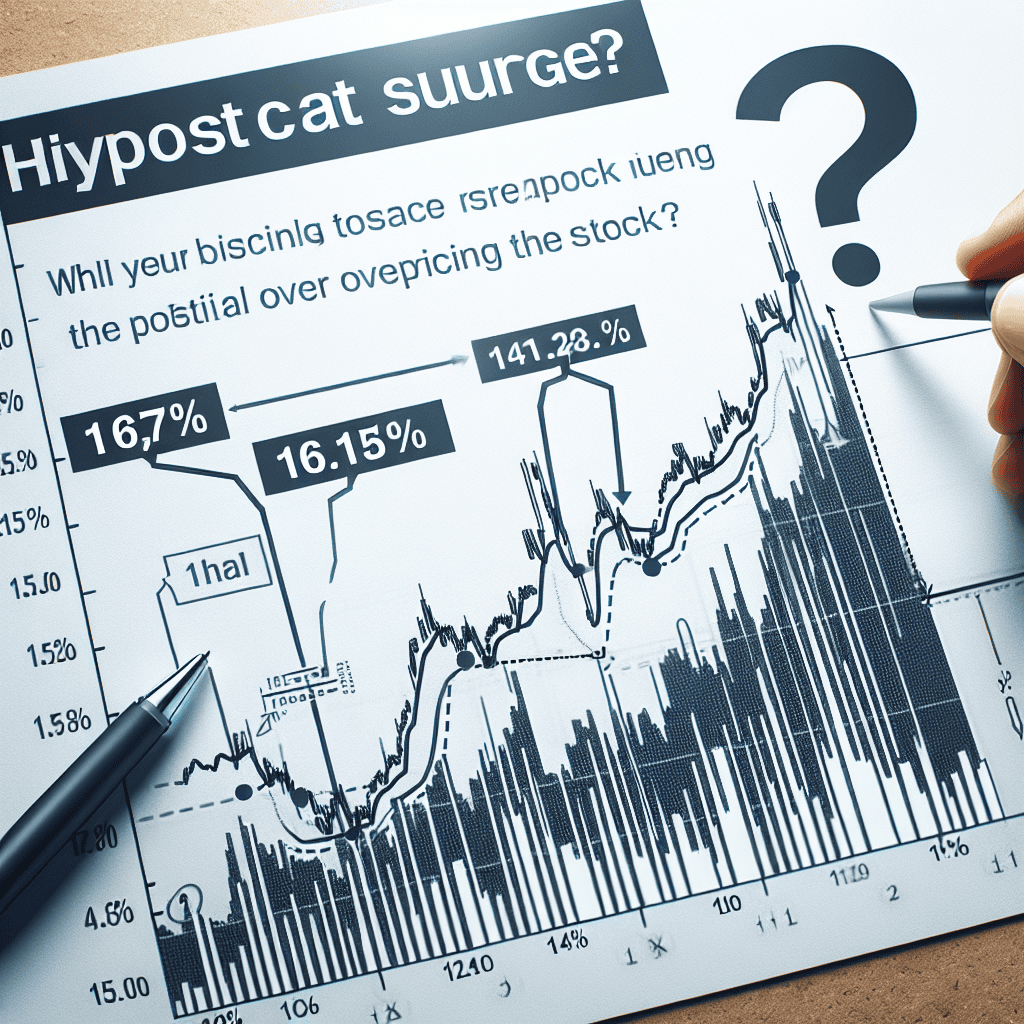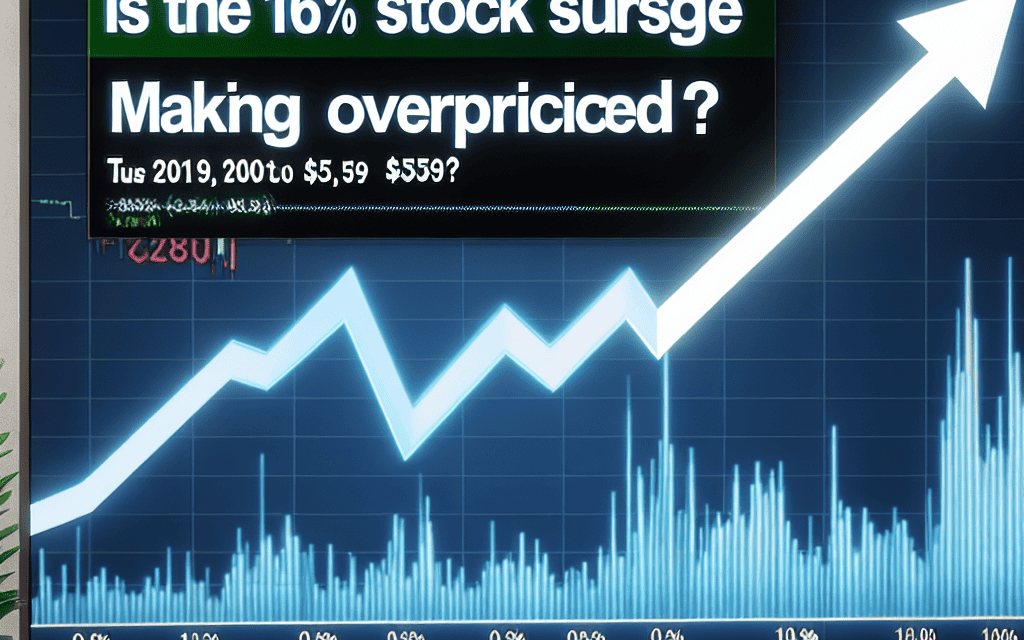“Riding the Wave or Risking the Fall: Evaluating Palantir’s Stock Surge.”
Introduction
Palantir Technologies, a prominent player in the data analytics and software industry, has recently captured significant attention in the financial markets due to a remarkable 161% surge in its stock price. This dramatic increase has sparked a debate among investors and analysts regarding the company’s current valuation and whether it may be considered overpriced. As Palantir continues to expand its footprint across various sectors, leveraging its cutting-edge technology to provide data-driven insights and solutions, the question of its stock’s true value becomes increasingly pertinent. Evaluating factors such as the company’s growth prospects, competitive positioning, and broader market conditions is essential to determine if the recent stock surge aligns with its intrinsic value or if it reflects an overvaluation driven by market exuberance.
Analyzing Palantir’s Recent Stock Surge: Is It Justified or Overhyped?
Palantir Technologies, a company renowned for its data analytics platforms, has recently experienced a remarkable 161% surge in its stock price, prompting investors and analysts alike to question whether this growth is justified or if the stock is becoming overpriced. To understand the dynamics behind this surge, it is essential to delve into the factors contributing to Palantir’s recent performance and assess whether these elements warrant such a significant increase in valuation.
One of the primary drivers behind Palantir’s stock surge is its strong financial performance. The company has consistently reported impressive revenue growth, driven by an expanding client base and increased demand for its data analytics solutions. Palantir’s ability to secure high-profile contracts with government agencies and large corporations has bolstered investor confidence, suggesting a robust and sustainable business model. Furthermore, the company’s focus on innovation and continuous improvement of its platforms has positioned it as a leader in the data analytics industry, further enhancing its appeal to investors.
In addition to its financial performance, Palantir’s strategic partnerships and collaborations have played a crucial role in its stock price appreciation. By aligning with key industry players and leveraging their expertise, Palantir has been able to expand its market reach and enhance its product offerings. These partnerships not only provide additional revenue streams but also reinforce Palantir’s reputation as a trusted and reliable partner in the data analytics space. Consequently, investors are optimistic about the company’s long-term growth prospects, contributing to the upward momentum of its stock price.
However, despite these positive indicators, some analysts caution that Palantir’s stock may be overhyped. The rapid increase in valuation has led to concerns about the company’s ability to sustain such growth in the long term. While Palantir’s current performance is impressive, the competitive landscape of the data analytics industry is constantly evolving, with new entrants and technological advancements posing potential challenges. As a result, there is a risk that Palantir’s growth may plateau if it fails to adapt to these changes and maintain its competitive edge.
Moreover, the high valuation of Palantir’s stock raises questions about its alignment with the company’s intrinsic value. Some investors argue that the current stock price reflects overly optimistic expectations, potentially leading to a market correction if the company fails to meet these expectations. This sentiment is further compounded by the broader market conditions, where high-growth tech stocks have experienced increased volatility, making it crucial for investors to exercise caution and conduct thorough due diligence before making investment decisions.
In conclusion, while Palantir’s recent stock surge can be attributed to its strong financial performance, strategic partnerships, and market leadership, it is essential to consider the potential risks and challenges that may impact its future growth. The question of whether Palantir’s stock is overpriced ultimately depends on one’s perspective on the company’s ability to navigate the competitive landscape and deliver sustained growth. As with any investment, a balanced approach that weighs both the opportunities and risks is crucial in determining whether Palantir’s stock surge is justified or overhyped. Investors should remain vigilant and informed, ensuring that their investment decisions align with their risk tolerance and long-term financial goals.
The Impact of Palantir’s 161% Stock Increase on Investor Sentiment
Palantir Technologies, a company renowned for its data analytics platforms, has recently experienced a remarkable 161% surge in its stock price. This dramatic increase has sparked a flurry of discussions among investors and analysts alike, raising questions about whether the stock is now overpriced. To understand the impact of this surge on investor sentiment, it is essential to delve into the factors driving this growth and the broader implications for the market.
Initially, Palantir’s stock surge can be attributed to several key factors. The company has consistently demonstrated strong financial performance, with impressive revenue growth and a robust pipeline of government and commercial contracts. Additionally, Palantir’s strategic partnerships and expansion into new markets have bolstered investor confidence. These developments have not only enhanced the company’s financial outlook but have also positioned it as a leader in the data analytics industry. Consequently, investors have been drawn to Palantir’s potential for long-term growth, contributing to the stock’s upward trajectory.
However, the rapid increase in Palantir’s stock price has also led to concerns about its valuation. Some analysts argue that the stock may be overpriced, given the current market conditions and the company’s earnings potential. The price-to-earnings ratio, a common metric used to assess a stock’s valuation, has reached levels that some consider unsustainable. This has prompted a debate among investors about whether Palantir’s stock is a prudent investment at its current price.
Despite these concerns, the surge in Palantir’s stock has undeniably influenced investor sentiment. On one hand, the significant increase has generated a sense of optimism among investors who believe in the company’s growth prospects. This optimism is further fueled by Palantir’s innovative technology and its ability to address complex data challenges across various industries. As a result, many investors are willing to overlook the high valuation, focusing instead on the potential for future gains.
On the other hand, the stock’s rapid ascent has also introduced a degree of caution among more risk-averse investors. The fear of a potential market correction or a decline in Palantir’s stock price has led some to adopt a more conservative approach. These investors are wary of the volatility that often accompanies such significant price movements and are concerned about the possibility of a bubble forming in the tech sector.
In light of these contrasting perspectives, it is crucial for investors to carefully evaluate their own risk tolerance and investment strategies. While Palantir’s stock surge presents an opportunity for substantial returns, it also carries inherent risks. Investors must weigh the potential rewards against the possibility of a downturn, considering both the company’s fundamentals and the broader market environment.
Ultimately, the impact of Palantir’s 161% stock increase on investor sentiment is multifaceted. It has sparked enthusiasm and optimism among some, while simultaneously prompting caution and skepticism among others. As the market continues to evolve, investors will need to remain vigilant, staying informed about Palantir’s performance and the factors influencing its stock price. By doing so, they can make informed decisions that align with their financial goals and risk tolerance, navigating the complexities of the ever-changing investment landscape.
Evaluating Palantir’s Valuation: Is the Stock Surge Sustainable?
Palantir Technologies, a company renowned for its data analytics platforms, has recently experienced a remarkable 161% surge in its stock price, prompting investors and analysts alike to question whether this growth is sustainable or if the stock is becoming overpriced. To evaluate Palantir’s current valuation, it is essential to consider several factors, including its financial performance, market position, and future growth prospects.
Firstly, Palantir’s financial performance has been a significant driver of its stock price increase. The company has consistently reported strong revenue growth, driven by its expanding customer base and the increasing demand for data-driven decision-making solutions. In recent quarters, Palantir has secured several high-profile contracts with government agencies and private sector companies, further solidifying its reputation as a leader in the data analytics space. However, despite this impressive revenue growth, Palantir has yet to achieve consistent profitability, which raises concerns about its long-term financial sustainability.
Moreover, Palantir’s market position is another critical factor to consider when evaluating its valuation. The company operates in a highly competitive industry, with numerous players vying for market share in the data analytics sector. While Palantir has established itself as a key player, particularly in government contracts, it faces stiff competition from both established technology giants and emerging startups. This competitive landscape could potentially impact Palantir’s ability to maintain its growth trajectory and justify its current valuation.
In addition to its financial performance and market position, Palantir’s future growth prospects are crucial in assessing whether the stock surge is sustainable. The company has been actively investing in research and development to enhance its product offerings and expand into new markets. Palantir’s focus on innovation and its ability to adapt to changing market dynamics will be vital in sustaining its growth. Furthermore, the increasing importance of data analytics across various industries presents significant opportunities for Palantir to capitalize on. However, the company’s reliance on government contracts, which can be subject to political and budgetary uncertainties, poses a potential risk to its future growth.
Transitioning to the broader market context, it is important to consider the overall sentiment in the technology sector, which has been characterized by high valuations and investor enthusiasm. This environment has contributed to the rapid appreciation of Palantir’s stock price. However, it also raises the possibility of a market correction, which could impact Palantir’s valuation. Investors should be cautious of the broader market trends and the potential for volatility in the technology sector.
In conclusion, while Palantir’s 161% stock surge reflects its strong financial performance and promising growth prospects, several factors warrant careful consideration when evaluating its valuation. The company’s lack of consistent profitability, competitive market position, and reliance on government contracts present potential challenges to sustaining its current growth trajectory. Additionally, the broader market environment and the possibility of a correction in the technology sector add further complexity to the assessment of Palantir’s valuation. Investors should weigh these factors carefully and consider both the opportunities and risks associated with Palantir’s stock before making investment decisions. Ultimately, whether Palantir’s stock is overpriced will depend on its ability to navigate these challenges and continue delivering value to its shareholders.
Market Reactions to Palantir’s Stock Performance: A Closer Look

Palantir Technologies, a company renowned for its data analytics platforms, has recently experienced a remarkable 161% surge in its stock price, prompting investors and market analysts to question whether this rapid appreciation has rendered the stock overpriced. This dramatic increase in valuation has been driven by a combination of factors, including strong financial performance, strategic partnerships, and a growing demand for data-driven decision-making solutions. However, as with any significant market movement, it is essential to examine the underlying causes and potential implications to determine if the current stock price accurately reflects the company’s intrinsic value.
To begin with, Palantir’s recent financial results have been a significant catalyst for its stock price surge. The company has consistently reported robust revenue growth, driven by an expanding customer base and increased adoption of its platforms across various industries. This growth trajectory has been further bolstered by Palantir’s ability to secure high-profile contracts with government agencies and large corporations, which not only provide a steady stream of revenue but also enhance the company’s reputation as a leader in the data analytics space. Consequently, investors have been optimistic about Palantir’s future prospects, contributing to the upward momentum in its stock price.
Moreover, Palantir’s strategic partnerships have played a crucial role in its recent stock performance. By collaborating with industry giants and leveraging their expertise, Palantir has been able to enhance its product offerings and expand its market reach. These partnerships have not only facilitated the development of innovative solutions but have also opened up new avenues for growth, thereby reinforcing investor confidence in the company’s long-term potential. As a result, the market has responded positively, further driving up the stock price.
However, despite these positive developments, there are concerns that Palantir’s stock may be overpriced. One of the primary reasons for this apprehension is the company’s valuation relative to its earnings. While Palantir has demonstrated impressive revenue growth, its profitability remains a point of contention. The company has yet to consistently achieve positive net income, which raises questions about its ability to sustain its current valuation in the absence of substantial earnings. This disconnect between revenue growth and profitability has led some analysts to caution that the stock may be overvalued, particularly when compared to its peers in the technology sector.
Additionally, the broader market environment has contributed to the perception that Palantir’s stock might be overpriced. The recent surge in technology stocks, fueled by low interest rates and investor enthusiasm for innovation, has led to elevated valuations across the sector. In this context, Palantir’s stock price increase may be reflective of a broader trend rather than company-specific factors, suggesting that the stock could be vulnerable to a market correction.
In conclusion, while Palantir’s 161% stock surge can be attributed to strong financial performance, strategic partnerships, and a favorable market environment, it is crucial to consider whether these factors justify the current valuation. The company’s profitability challenges and the broader market dynamics suggest that caution may be warranted. As investors continue to assess Palantir’s long-term potential, it remains to be seen whether the stock’s recent gains are sustainable or indicative of an overheated market. Ultimately, a careful analysis of both the company’s fundamentals and the external market conditions will be essential in determining whether Palantir’s stock is indeed overpriced.
Palantir’s Growth Trajectory: What Does a 161% Stock Surge Indicate?
Palantir Technologies, a company renowned for its data analytics platforms, has recently experienced a remarkable 161% surge in its stock price, prompting investors and analysts to question whether this growth trajectory has rendered the stock overpriced. To understand the implications of this surge, it is essential to delve into the factors driving Palantir’s growth and assess whether the current valuation aligns with the company’s long-term potential.
Firstly, Palantir’s impressive stock performance can be attributed to its robust financial results and strategic positioning in the data analytics sector. The company has consistently reported strong revenue growth, driven by an expanding customer base and increased demand for its cutting-edge solutions. Palantir’s platforms, such as Gotham and Foundry, have become indispensable tools for government agencies and private enterprises seeking to harness the power of big data. This growing reliance on data-driven decision-making has positioned Palantir as a key player in the industry, thereby boosting investor confidence and contributing to the stock’s upward trajectory.
Moreover, Palantir’s strategic partnerships and collaborations have further fueled its growth. The company has successfully forged alliances with major corporations and government entities, enhancing its credibility and expanding its market reach. These partnerships not only provide Palantir with a steady stream of revenue but also enable it to leverage the expertise and resources of its partners to drive innovation and improve its offerings. Consequently, these collaborations have played a significant role in sustaining the company’s growth momentum and justifying the recent surge in its stock price.
However, despite these positive developments, concerns about Palantir’s valuation persist. Critics argue that the stock’s current price may not be sustainable in the long term, given the competitive landscape and potential challenges the company may face. The data analytics sector is highly competitive, with numerous players vying for market share. As a result, Palantir must continuously innovate and differentiate itself to maintain its competitive edge. Failure to do so could lead to a slowdown in growth, which may not justify the current valuation.
Additionally, Palantir’s reliance on government contracts poses a potential risk. While these contracts have been a significant source of revenue, they are subject to political and budgetary uncertainties. Any changes in government spending priorities or regulatory environments could impact Palantir’s financial performance, thereby affecting its stock price. Investors must consider these factors when evaluating whether the current valuation accurately reflects the company’s future prospects.
In light of these considerations, it is crucial for investors to adopt a balanced perspective when assessing Palantir’s stock surge. While the company’s impressive growth trajectory and strategic initiatives are undeniably promising, potential risks and challenges must not be overlooked. Investors should carefully evaluate Palantir’s ability to sustain its competitive advantage and navigate the complexities of the data analytics sector.
In conclusion, Palantir’s 161% stock surge is indicative of the company’s strong growth potential and strategic positioning in the data analytics industry. However, whether this surge has rendered the stock overpriced remains a matter of debate. By weighing the company’s growth prospects against potential risks, investors can make informed decisions about the stock’s valuation and its alignment with their investment objectives. As Palantir continues to evolve and adapt to the dynamic market landscape, its future performance will ultimately determine whether the current stock price is justified.
Risks and Rewards: Investing in Palantir After Its Stock Surge
Palantir Technologies, a company renowned for its data analytics platforms, has recently experienced a remarkable 161% surge in its stock price. This dramatic increase has captured the attention of investors and market analysts alike, prompting a closer examination of whether the stock is now overpriced. As with any investment, there are inherent risks and rewards, and understanding these is crucial for making informed decisions.
To begin with, Palantir’s impressive stock performance can be attributed to several factors. The company has consistently demonstrated its ability to secure high-profile contracts, particularly with government agencies and large corporations. This has bolstered investor confidence in its long-term growth prospects. Furthermore, Palantir’s innovative technology and its potential applications across various industries have positioned it as a leader in the data analytics space. These elements have contributed to the stock’s upward trajectory, making it an attractive option for investors seeking growth opportunities.
However, the rapid increase in Palantir’s stock price also raises concerns about its current valuation. Some analysts argue that the stock may be overpriced, given the company’s financial metrics. For instance, Palantir’s price-to-earnings (P/E) ratio is significantly higher than the industry average, suggesting that the stock may be trading at a premium. This could indicate that investors are overly optimistic about the company’s future earnings potential, which may not materialize as expected. Consequently, there is a risk that the stock could experience a correction if market sentiment shifts or if the company fails to meet growth expectations.
Moreover, Palantir faces several challenges that could impact its future performance. The competitive landscape in the data analytics industry is intensifying, with numerous companies vying for market share. This increased competition could pressure Palantir to innovate continuously and maintain its technological edge, which may require substantial investment. Additionally, the company’s reliance on government contracts exposes it to regulatory and political risks, which could affect its revenue streams.
Despite these risks, there are compelling reasons to consider investing in Palantir. The company’s strong track record of securing contracts and its expanding client base suggest that it is well-positioned to capitalize on the growing demand for data analytics solutions. Furthermore, Palantir’s focus on developing cutting-edge technology and its commitment to innovation could drive future growth and enhance its competitive advantage. For investors with a higher risk tolerance, these factors may outweigh the potential downsides.
In conclusion, the decision to invest in Palantir following its 161% stock surge requires careful consideration of both the risks and rewards. While the stock’s current valuation may appear steep, the company’s growth prospects and market position offer significant potential for long-term gains. Investors must weigh these factors against the inherent risks, including market volatility and competitive pressures. Ultimately, a thorough analysis of Palantir’s financial health, industry dynamics, and strategic initiatives will be essential for making an informed investment decision. As with any investment, diversification and a clear understanding of one’s risk tolerance are key to navigating the complexities of the stock market.
Comparing Palantir’s Stock Surge to Industry Peers: Overpriced or On Par?
Palantir Technologies, a company renowned for its data analytics platforms, has recently experienced a remarkable 161% surge in its stock price. This dramatic increase has sparked a debate among investors and analysts regarding whether the stock is now overpriced or if it remains on par with its industry peers. To better understand this phenomenon, it is essential to compare Palantir’s performance with that of similar companies in the technology and data analytics sectors.
Firstly, it is important to consider the broader market context in which Palantir operates. The technology sector has been experiencing significant growth, driven by an increasing reliance on data-driven decision-making across various industries. Companies that provide data analytics solutions, like Palantir, have been at the forefront of this trend, benefiting from heightened demand for their services. However, while the sector as a whole has seen growth, Palantir’s stock surge stands out as particularly pronounced, raising questions about its valuation.
When comparing Palantir to its industry peers, one must examine key financial metrics such as price-to-earnings (P/E) ratios, revenue growth, and market capitalization. Palantir’s P/E ratio, for instance, is notably higher than the industry average, suggesting that investors are willing to pay a premium for its shares. This could be attributed to the company’s strong brand recognition and its reputation for providing cutting-edge solutions to complex data challenges. However, a high P/E ratio can also indicate that a stock is overpriced, as it implies that future earnings growth is already priced in.
In terms of revenue growth, Palantir has demonstrated impressive performance, consistently reporting double-digit increases in its quarterly earnings. This growth is largely driven by its expanding client base, which includes government agencies and large corporations seeking to leverage data for strategic advantage. While this growth trajectory is commendable, it is crucial to compare it with that of other companies in the sector. Some of Palantir’s competitors have also reported robust revenue growth, albeit at a more moderate pace, which may suggest that Palantir’s stock surge is somewhat justified by its superior performance.
Market capitalization is another factor to consider when evaluating whether Palantir’s stock is overpriced. The company’s market cap has ballooned in tandem with its stock price, positioning it among the top players in the data analytics industry. However, when compared to other tech giants, Palantir’s market cap still lags behind, indicating that there may be room for further growth. This perspective could support the argument that Palantir’s stock is not necessarily overpriced but rather reflective of its potential to capture a larger share of the market.
In conclusion, while Palantir’s 161% stock surge is undeniably impressive, determining whether it is overpriced requires a nuanced analysis of its financial metrics and comparison with industry peers. The company’s high P/E ratio and rapid revenue growth suggest that investors have high expectations for its future performance. However, these factors must be weighed against the broader market context and the performance of similar companies. Ultimately, whether Palantir’s stock is overpriced or on par with its peers depends on one’s perspective on its growth potential and the sustainability of its current trajectory. As with any investment, potential investors should conduct thorough research and consider multiple factors before making a decision.
Q&A
1. **What is Palantir’s recent stock performance?**
Palantir’s stock has surged by 161% recently.
2. **What factors contributed to Palantir’s stock surge?**
The surge can be attributed to strong earnings reports, increased demand for data analytics, and strategic partnerships.
3. **How does Palantir’s valuation compare to its industry peers?**
Palantir’s valuation is higher than many of its industry peers, raising concerns about it being overpriced.
4. **What are analysts saying about Palantir’s stock price?**
Analysts are divided, with some suggesting the stock is overpriced while others believe in its long-term growth potential.
5. **What are the risks associated with investing in Palantir at its current price?**
Risks include potential overvaluation, market volatility, and dependency on government contracts.
6. **What are the growth prospects for Palantir?**
Palantir has strong growth prospects due to its expanding customer base and innovative technology solutions.
7. **Is Palantir’s stock considered a good buy at its current price?**
Opinions vary; some investors see potential for further growth, while others caution about the high valuation.
Conclusion
Palantir’s 161% stock surge has raised concerns about its valuation, with some investors questioning whether the stock is now overpriced. The surge can be attributed to factors such as increased demand for data analytics, strategic partnerships, and positive financial performance. However, the rapid increase in stock price may not fully reflect the company’s intrinsic value, as it could be driven by market speculation and investor sentiment. Additionally, Palantir’s high price-to-earnings ratio compared to industry peers suggests that the stock may be overvalued. Investors should carefully assess the company’s fundamentals, growth prospects, and market conditions before making investment decisions, as the current stock price may not be sustainable in the long term.





